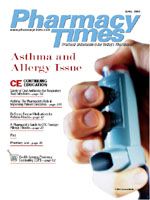Publication
Article
Pharmacy Times
Are Allergies on the Rise?
Author(s):
An unknown comedian once said, "The difference between an itch and an allergy is about a hundred bucks."It is ironic that the cost of an allergy-related office visit is ~$100, and such visits have increased dramatically in the past decade. Epidemiologists suspect that heightened public awareness and improved diagnostic testing are the underlying causes of the increase, but research indicates otherwise. Studies have confirmed that allergy-related sniffling, red and itchy eyes, and rash are more common today than previously, particularly in such industrialized countries as England, Canada, Greenland, New Zealand, Australia, Denmark, and the United States. Nonindustrialized countries and rural areas have lower prevalence rates.1-7
In the United States, for example, rhinitis, the common symptom of allergy, increased by 31% from 1985 to 1995; pediatric peanut allergies doubled from 1997 to 2002; and asthma increased from 35 cases per 1000 in 1982 to 56 cases per 1000 in 1994.2,5,8 Up to 50% of people in developed areas may suffer from some form of allergy9 (Table 1).
The Culprits
Sensitivity to pollens, dust mite droppings, and animal fur accounts for ~90% of allergies.11 Sensitivity to food and food additives (Table 2), insects, latex, chemicals, industrial ingredients, and particulates in the air is responsible for the bulk of the remaining cases. Because a person can become allergic to any environmental agent, allergists find accurate diagnosis of idiopathic allergens challenging.
Why the immune system mounts an attack against seemingly harmless agents baffles researchers. Because the immune system treats the harmless agent as a threat, B lymphocytes produce immunoglobulin E antibody (IgE). IgE attaches to mast cells such as those present in the nasal and bronchial passages, resulting in histamine release. Inflammation and allergy symptoms follow. Once sensitized, mast cells automatically release histamine when the invading agent reappears. Because IgE can sensitize cells anywhere in the body, individuals' symptoms vary (eg, a cat may produce hives in one person and generate sneezing in another person).9,11
Allergy should not be confused with atopy. Atopy indicates that a person has developed a symptomless sensitization.
The Increase in Allergies
A genetic susceptibility to allergens has been established, but a shift in the human gene pool is an unlikely explanation for the increased prevalence of allergies. Shifts in population-based traits require several generations to emerge; yet researchers have reported allergy increases within the same generation. In one study, for example, frozen blood samples were randomly selected from syphilis screening initiatives conducted in 1987 and compared with those randomly selected from a 1998 HIV screening. The presence of IgE to common allergens in the 1998 sample was double that of the earlier sample.7
Two of the numerous theories proposed have empirical support. They are the allergen exposure hypothesis and the hygiene hypothesis.
Allergen Exposure Hypothesis
Simply stated, increased exposure to allergens leads to increased sensitivity. Today, people eat diverse and exotic foods, many containing artificial preservatives and additives; spend more time indoors, increasing contact with dust, synthetic materials, and household chemicals; are more likely to maintain pets indoors; and are exposed to more pollution. The exposure theory is supported by the increased prevalence of allergies primarily in developed countries, and mostly in urban environments, as opposed to rural communities.6
Hygiene Hypothesis
This theory supposes that inadequate exposure to genuinely harmful agents leads to immune dysfunction. Under normal circumstances, the immune system is exposed to various viral, bacterial, fungal, or parasitic challenges and becomes strengthened following successful defenses. Today's public health successes, coupled with the increased use of antibiotics, minimize opportunities to mount successful attacks against genuine attackers. IgE is still present, however, and, in the absence of harmful agents, it begins attacking harmless environmental substances.6
Supporting evidence is ample. Children who have had early infections demonstrate less atopy. Populations in which parasitic infestation is common manifest lower levels of hay fever and asthma. People who have had measles have fewer allergies, as do children with multiple siblings.6 Animal studies also support the hygiene theory; mice treated with antibiotics showed greater sensitivity to mold allergens.12 The hygiene theory, however, cannot satisfactorily explain the high prevalence of allergies in poor inner-city housing, where potential exposure to harmful agents is increased. Similarly, gross antibiotic sales do not correlate with prevalence shifts.13
The increase in allergies is most probably due to the interaction of several factors, including genetic susceptibility. Until researchers can identify true causal factors, as opposed to enhancing factors, theories will coexist.9
Treatment
Avoidance strategies work for some allergies (eg, latex), but avoidance is impossible for many sufferers, and symptom management is essential. Oral antihistamines and decongestants remain the cornerstones of treatment; newer, second-generation, nonsedating antihistamines result in fewer side effects. Other treatment options include anti-inflammatory agents such as mast cell stabilizers (eg, cromolyn, nedocromil, lodoxamide); corticosteroids; antileukotrienes (eg, zileuton); and bronchodilators, including betaagonists, anticholinergics, and theophylline. Antihistamines combined with corticosteroids seem to produce maximum effect for many people.14
A new therapeutic class, anti-IgE, was FDA-approved in 2003 with omalizumab. This drug inhibits free IgE, preventing it from attaching to allergens. Current use, however, is restricted to patients with allergic asthma whose symptoms are inadequately controlled by other treatments. It must be administered subcutaneously every 2 to 4 weeks and dosed to body weight and total serum IgE levels.14
Future allergy treatments will be highly selective IgE synthesis inhibitors, as well as targeted long-acting mast cell inhibitors (current agents are short-acting). Toward that goal, several monoclonal antibodies are already in development, with preliminary positive results.9
Education
A survey has found that 83% of allergy sufferers named medications as their first treatment option, with 80% believing medications to be safe.15 The majority (61%) reported advertisements as their information source,15 suggesting that the public may be underinformed about side effects, drug interactions, and contraindications for comorbid conditions.
Approximately 52% of allergy patients seek pharmacist counseling.11 Given the undisputed increase in allergies, patients'questions are numerous, and pharmacists should be equipped with an arsenal of counseling tips.
Dr. Zanni is a psychologist and health-systems consultant based in Alexandria, Va.
For a list of references, send a stamped, self-addressed envelope to: References Department, Attn. A. Stahl, Pharmacy Times, 241 Forsgate Drive, Jamesburg, NJ 08831; or send an e-mail request to: [email protected].

Newsletter
Stay informed on drug updates, treatment guidelines, and pharmacy practice trends—subscribe to Pharmacy Times for weekly clinical insights.






